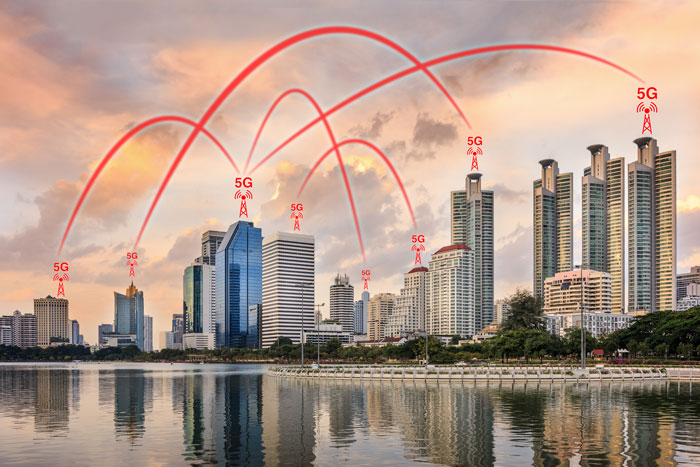By: Reza Rassool
5G is nearly here, already boldly transforming the way we interact with and consume media. Its increased available bandwidth can support vast amounts of data. This much-anticipated speed and connectivity have been widely reported as game-changing, and I can say with confidence those reports contain no exaggeration.
In the world of computer vision, 5G will disrupt the industry most noticeably by providing over the top (OTT) access to IoT devices, opening up not just new use cases, but a whole new category for this extraordinary technology (more on that category in a bit). I’m excited to share specifically how 5G will make SAFR, RealNetworks’ facial recognition solution, more powerful and more widely accessible:
1. 5G Operates at the Edge
SAFR will do more than work well in a 5G environment; it will thrive. Why? Because the architecture is so similar: 5G’s split architecture goes OTT, and SAFR Edge handles detection, sending recognition up to the cloud, enabling efficient processing of live video. SAFR Edge can be hosted on 5G MEC (multi-access edge computing).
In fact, SAFR’s sweet spot is facial recognition for live video, detecting and recognizing faces in real-time with low latency (SAFR delivers exceptionally accurate matches in under 100 milliseconds). In the same way that RealNetworks pioneered streaming media over low-bandwidth internet connections, we’re solving the hardest problem in computer vision: facial recognition in live video, in the wild, and in real time. Since 5G is meant for low-latency, real-time applications, it’s clear to see how SAFR and 5G are an ideal match.
2. 5G Offers Simpler Device Connection
Face it, existing IoT onboarding is complicated. It requires connecting your mobile phone to the IoT device’s WiFi network for initial authentication, pairing, and setup, and then switching back to the home network. With 5G, IoT devices are connected directly to the cloud, bypassing both on-prem gateways to the network and commercial gatekeepers to reach cloud services.
SIM cards are already installed and authenticated, so it’s an incredibly fast and secure way to get SAFR up and running. This also enables carrier billing, further reducing friction.
3. 5G Offers More Dependability
Another advantage to 5G’s connectivity is its increased dependability. Consider how vulnerable smart homes become if the power is cut or a weather event leads to an outage. On 5G, devices connected to the cellular network are fully operational, so smart homes remain online, and remain protected.
Since many of us use our mobile phones in place of landlines, if we can’t efficiently connect to wireless networks, we can’t always get up-to-date information. On 5G networks, devices continue to function as normal. Having limited-to-no downtime is of critical importance in facial recognition, and 5G will move the needle for SAFR closer to zero.
4. 5G Offers More Bandwidth
With 20 times greater bandwidth than 4G networks, 5G can support many more devices on the network. For SAFR customers, this means the ability to run more cameras with greater connectivity.
SAFR currently supports up to 16 cameras per server, optimal for the security industry, in which a higher level of visibility across all camera feeds spells the difference between possibly letting a person of interest walk across a feed without being noticed and enhancing a security team’s ability to respond to security events in real time. In many use cases, this efficient bandwidth also translates to a significant reduction in TCO, making SAFR a viable solution for a wider range of customers.
5. 5G Unlocks a New Category
Perhaps most exciting of all, the unparalleled benefits of 5G open the doors to a new tech category for facial recognition: wearables.
As the fastest, most compact, and most accurate facial recognition algorithm on the market, SAFR is driving computer vision into IoT devices, making it ideally suited for smarter 5G cameras, bodycams, and other wearables.
Imagine being able to run SAFR on a camera that’s completely autonomous — solar-powered and free of wires. With technology advancements, SAFR will be in a position to transform outcomes for first responders arriving at the scene of an emergency — a SAFR-powered bodycam filled with a database of injured or missing persons not only delivers more efficient care, but also peace of mind for family members awaiting news of their loved ones. With wearables, the possibilities are endless, from 5G cameras for smart city applications like pathing and flow monitoring to SAFR being used on a lapel camera by blind persons with an in-ear voice assistant recognizing the people around them. 5G brings these applications much closer to reality.
Our goal is to harness 5G to bring computer vision to smaller devices. SAFR is rapidly evolving as it adapts to 5G, setting the stage for exciting new possibilities in facial recognition for businesses and consumers alike.

